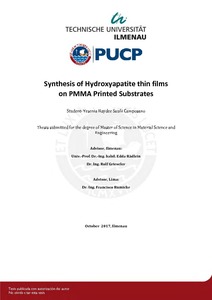| dc.contributor.advisor | Rädlein, Edda | |
| dc.contributor.advisor | Grieseler, Rolf | |
| dc.contributor.author | Sauñi Camposano, Yesenia Haydee | es_ES |
| dc.date.accessioned | 2018-01-19T21:31:00Z | es_ES |
| dc.date.available | 2018-01-19T21:31:00Z | es_ES |
| dc.date.created | 2017 | es_ES |
| dc.date.issued | 2018-01-19 | es_ES |
| dc.identifier.uri | http://hdl.handle.net/20.500.12404/9902 | |
| dc.description.abstract | Each year millions of people suffer from bone defects resulting from trauma, tumors or
bone-related injuries. Therefore there is a need to continuously develop new materials or
improve the properties of the materials currently used, for bone replacement or implant
applications. Polymethyl methacrylate (PMMA) has proven to be a promising alternative
as a material for implants; however, there are still some limitations inherent to this
material, particularly related to its surface properties.
This thesis work is focused on the fabrication of hydroxyapatite (HAp) thin films on the
surface of 3D printed PMMA substrates. 3D printing, particularly the Fused Deposition
Modeling (FDM) technique was used to fabricate PMMA substrates with different surface
porosity levels. FDM technique exhibits the potential for fabricating customized freeform
structures for several applications including craniofacial reconstruction. HAp thin films
were deposited by Radio Frequency Magnetron Sputtering (RFMS) and Ion Beam
Sputtering (IBS) techniques, with a commercial target and an “in house” sintered target,
respectively. A structural, chemical, mechanical, and morphological characterization was
conducted in the generated surfaces by means of X-ray diffraction (XRD), scanning
electron microscopy (SEM), energy dispersive spectroscopy (EDS), and hardness and
roughness measurements.
The results of the XRD analysis revealed an amorphous structure for the films produced by
both RFMS and IBS techniques on the PMMA substrates. The micrographs obtained by
SEM showed a columnar morphology and a low density for the films produced by RFMS;
the same technique revealed a structure of ridges of standing platelets with curved
contours for the IBS deposited films. The amorphous structure and the morphology of the
films, as well as the hardness and roughness can be propitious to improve surface
properties and promote the osseointegration capabilities of PMMA.
This work contributes to the basis for the development of a PMMA implant manufacturing
process using 3D printing and HAp film deposition techniques, with improved
osseointegration properties. | es_ES |
| dc.description.abstract | Cada año, millones de personas sufren defectos óseos como resultado de traumas, tumores
o lesiones relacionadas con los huesos. Por lo tanto, existe la necesidad de desarrollar
continuamente nuevos materiales o mejorar las propiedades de los materiales utilizados
actualmente, para aplicaciones de reemplazo óseo o implantes. El polimetilmetacrilato
(PMMA) ha demostrado ser una alternativa prometedora como material para implantes;
sin embargo, todavía existen algunas limitaciones inherentes a este material,
particularmente relacionadas con sus propiedades superficiales.
Este trabajo de tesis se centra en la fabricación de películas delgadas de hidroxiapatita
(HAp) en la superficie de sustratos de PMMA impresos en 3D. La impresión 3D,
particularmente la técnica de modelado de deposición fundida (FDM), se utilizó para
fabricar sustratos de PMMA con diferentes niveles de porosidad superficial. La técnica
FDM exhibe el potencial para fabricar estructuras personalizadas de para varias
aplicaciones, incluida la reconstrucción craneofacial. Las películas delgadas de HAp se
depositaron mediante técnicas de deposición catódica con Magnetrón y radio frecuencia
(RFMS) y deposición catódica con haz de iones (IBS), con un target comercial y un target
sinterizado "in house", respectivamente. Se realizó una caracterización estructural,
química, mecánica y morfológica en las superficies generadas por medio de difracción de
rayos X (XRD), microscopía electrónica de barrido (SEM), espectroscopía de energía
dispersiva (EDS) y medidas de dureza y rugosidad.
Los resultados del análisis de XRD revelaron una estructura amorfa para las películas
producidas por ambas técnicas RFMS e IBS en los sustratos de PMMA. Las micrografías
obtenidas por SEM mostraron una morfología columnar y una baja densidad para las
películas producidas por RFMS; la misma técnica reveló una estructura de crestas de
plaquetas con contornos curvados para las películas depositadas IBS. La estructura amorfa
y la morfología de las películas, así como la dureza y la rugosidad pueden ser propicias
para mejorar las propiedades de la superficie y promover las capacidades de
oseointegración del PMMA.
Este trabajo contribuye a la base para el desarrollo de un proceso de fabricación de
implantes de PMMA usando impresión 3D y técnicas de deposición de película HAp, con
propiedades mejoradas de oseointegración. | es_ES |
| dc.description.uri | Tesis | es_ES |
| dc.language.iso | eng | es_ES |
| dc.publisher | Pontificia Universidad Católica del Perú | es_ES |
| dc.rights | info:eu-repo/semantics/openAccess | es_ES |
| dc.rights.uri | http://creativecommons.org/licenses/by-nc-nd/2.5/pe/ | * |
| dc.subject | Hidrocarburos policíclicos aromáticos | es_ES |
| dc.subject | Películas delgadas | es_ES |
| dc.subject | Implantes artificiales | es_ES |
| dc.title | Synthesis of Hydroxyapatite thin films on PMMA Printed Substrates | es_ES |
| dc.type | info:eu-repo/semantics/masterThesis | es_ES |
| thesis.degree.name | Maestro en Ingeniería y Ciencia de los Materiales | es_ES |
| thesis.degree.level | Maestría | es_ES |
| thesis.degree.grantor | Pontificia Universidad Católica del Perú. Escuela de Posgrado | es_ES |
| thesis.degree.discipline | Ingeniería y Ciencia de los Materiales | es_ES |
| renati.discipline | 713017 | es_ES |
| renati.level | https://purl.org/pe-repo/renati/level#maestro | es_ES |
| renati.type | http://purl.org/pe-repo/renati/type#tesis | es_ES |
| dc.publisher.country | PE | es_ES |
| dc.subject.ocde | https://purl.org/pe-repo/ocde/ford#2.05.01 | es_ES |






